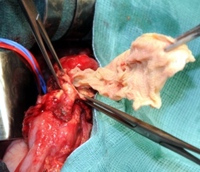A Bizarre Abdominal Cystic Lesion
Abstract
In spite of careful intraoperative precautions and gauze counts, mistakes can still occur during surgery. In the case reported, a retained gauze leaved during a surgical approach for removing a solid-cystic papillary tumor localized in the pancreatic tail, caused both persistent abdominal discomfort and the presence of an abdominal cystic lesion at imaging techniques. When a previous operative history is present, a foreign body should be taken into account in the differential diagnosis of a patient with an intra-abdominal cystic mass. Finally, radio-opaque marker should be routinely used by surgeons in order to reach a correct diagnosis in operated patients having retained gauze.
Image: The cyst was then opened ...
Downloads
References
Casadei R, Santini D, Calculli L, Pezzilli R, Zanini N, Minni F. Pancreatic solid-cystic papillary tumor: clinical features, imaging findings and operative management. JOP. J Pancreas (Online) 2006; 7(1 Suppl.):137-44. [PMID 16407636]
Alotti N, Kecskes G, Simon J, Tomcsanyi J, Papp L. Gauze swabs left intrapericardially following cardiac surgery. J Cardiovasc Surg 1999; 40:825-7. [PMID 10776712]
Fujita K, Ichikawa T. Encapsulated paravesical foreign body. J Urol 1990; 143:1004-5. [PMID 2184250]

Copyright (c) 2010 Giorgia Zucchini, Raffaele Pezzilli, Claudio Ricci, Riccardo Casadei, Donatella Santini, Lucia Calculli, Roberto Corinaldesi

This work is licensed under a Creative Commons Attribution 4.0 International License.
As a member of Publisher International Linking Association, PILA, iMedPub Group’s JOP follows the Creative Commons Attribution License and Scholars Open Access publishing policies. Journal of the Pancreas is the Council Contributor Member of Council of Science Editors (CSE) and following the CSE slogan Education, Ethics, and Evidence for Editors.